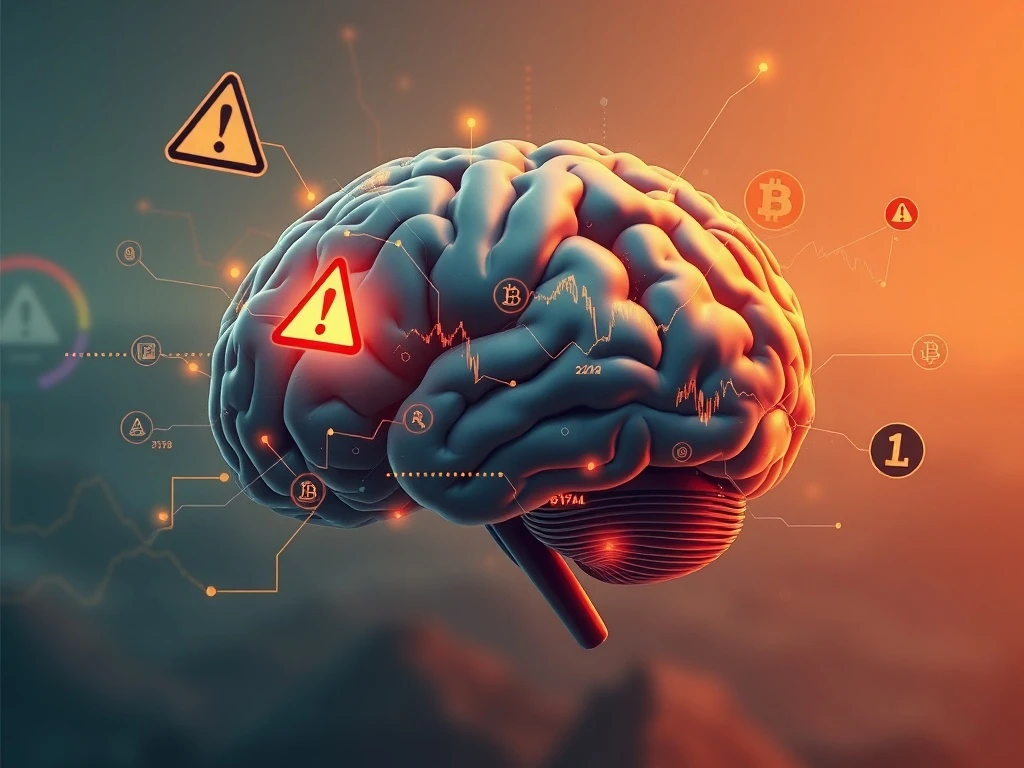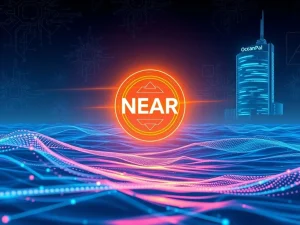ChatGPT: Unlocking Crucial Crypto Market Crash Warnings

The volatile world of cryptocurrency often leaves investors seeking an edge. Many wonder if ChatGPT crypto prediction tools can truly forecast the next major market downturn. While no AI can offer a crystal ball, advanced language models like ChatGPT are transforming how we approach market risks. This article explores ChatGPT’s powerful role in identifying early warning signs, helping traders navigate complex market conditions.
Decoding ChatGPT’s Role in Crypto Market Crash Detection
ChatGPT cannot precisely time a crypto market crash. Instead, it serves as a powerful risk detection tool. It identifies early warning signs by merging diverse data streams. This helps traders detect risk clusters before markets break. Large language models (LLMs) are now vital in crypto analytical workflows. Many trading desks, funds, and research teams use LLMs. They process vast volumes of headlines. They summarize on-chain data metrics. Furthermore, they track community sentiment. When markets become frothy, the question arises: Can ChatGPT predict the next crash? The answer lies in its ability to synthesize information and flag anomalies.
Lessons from the October 2025 Liquidation Wave
A hypothetical liquidation cascade in October 2025 offers a crucial case study. Within 24 hours, over $19 billion in leveraged positions vanished. Global markets reacted to a surprise US tariff announcement. Bitcoin (BTC) plunged from above $126,000 to around $104,000. This marked one of its sharpest single-day drops. Implied volatility in Bitcoin options spiked and remained high. In contrast, the equity market’s CBOE Volatility Index (VIX) cooled. This mix of macro shocks, structural leverage, and emotional panic creates a prime environment for AI crypto analysis. It may not forecast the exact day of a meltdown. However, it can assemble early warning signals. These signals often hide in plain sight if the workflow is set up correctly.
- Leverage Saturation: Open interest on major exchanges hit record highs. Funding rates turned negative, indicating overcrowded long positions.
- Macro Catalysts: Tariff escalation and export restrictions amplified systemic fragility. This impacted crypto derivatives markets significantly.
- Volatility Divergence: Bitcoin’s implied volatility stayed high. Meanwhile, equity volatility declined. This suggested crypto-specific risks were building independently.
- Community Sentiment Shift: The Fear and Greed Index plummeted. Discussions moved from optimism to warnings of ‘liquidation season.’
- Liquidity Vanished: Cascading liquidations triggered auto-deleveraging. Spreads widened and bid depth thinned, amplifying the sell-off.
These indicators were not hidden. The real challenge involves interpreting them together. It also means weighing their importance. Language models can automate this task far more efficiently than humans.
What ChatGPT Can Realistically Achieve in AI Crypto Analysis
Understanding ChatGPT’s true capabilities is essential. It excels at processing and synthesizing vast amounts of information. This capability makes it a valuable tool for AI crypto analysis, providing nuanced insights into market dynamics.
Synthesizing Narratives and Sentiment
ChatGPT can process thousands of posts and headlines. This helps it identify shifts in market narrative. When optimism fades, anxiety-driven terms begin to dominate. Terms like “liquidation,” “margin,” or “sell-off” become prevalent. The model quantifies this change in tone. For example, a prompt might ask it to summarize sentiment themes across Reddit and news headlines. It quantifies changes in negative terms week-over-week. This highlights shifts in trader mood and headline tone. The resulting summary forms a sentiment index. This index tracks whether fear or greed is increasing, providing crucial input for ChatGPT crypto prediction models.
Correlating Textual and Quantitative Data
Linking text trends with numerical indicators is another strength. Funding rates, open interest, and volatility are key examples. ChatGPT helps estimate probability ranges for different market risk conditions. For instance, it can correlate sentiment signals from social media with funding rates. If open interest is in the 90th percentile, funding turns negative, and mentions of ‘margin call’ rise significantly, the model can classify market risk as ‘High.’ Such contextual reasoning generates qualitative alerts. These alerts align closely with real market data, enhancing early detection of a potential crypto market crash.
Generating Conditional Risk Scenarios
Instead of direct prediction, ChatGPT excels at outlining conditional if-then relationships. It describes how specific market signals may interact. This occurs under various scenarios. For example, a prompt could ask it to produce concise if-then risk scenarios. It uses market and sentiment data. If implied volatility exceeds its 180-day average, and exchange inflows surge amid weak macro sentiment, it might assign a 15%-25% probability of a short-term drawdown. Scenario language keeps the analysis grounded and falsifiable. This approach supports proactive crypto risk management strategies.
Post-Event Analysis for Improved On-chain Data Interpretation
After volatility subsides, ChatGPT can review pre-crash signals. This evaluates which indicators proved most reliable. This retrospective insight helps refine analytical workflows. It prevents repeating past assumptions. It continuously improves the model’s ability to interpret complex data, including on-chain data. This iterative process is vital for enhancing the accuracy and utility of AI in market analysis.
Implementing Crypto Risk Management with ChatGPT
A conceptual understanding of ChatGPT is useful. However, applying it to risk management requires a structured process. This workflow turns scattered data points into a clear, daily risk assessment. Effective crypto risk management relies on robust data and clear interpretation.
Step 1: Data Ingestion – The Foundation of On-chain Data Analysis
The system’s accuracy depends on input quality, timeliness, and integration. Continuously collect and update three primary data streams:
- Market Structure Data: This includes open interest, perpetual funding rates, futures basis, and implied volatility (e.g., DVOL) from major derivatives exchanges.
- On-chain Data: Indicators like net stablecoin flows onto/off exchanges, large “whale” wallet transfers, wallet-concentration ratios, and exchange reserve levels provide deep insights into market health.
- Textual (Narrative) Data: Macroeconomic headlines, regulatory announcements, exchange updates, and high-engagement social media posts shape sentiment and narrative.
These diverse data sources feed the AI crypto analysis engine, ensuring a comprehensive view.
Step 2: Data Hygiene and Pre-processing
Raw data is inherently noisy. To extract meaningful signals, it must be cleaned and structured. Tag each data set with metadata. This includes timestamp, source, and topic. Apply a heuristic polarity score (positive, negative, or neutral). Most importantly, filter out duplicate entries, promotional “shilling,” and bot-generated spam. This maintains data integrity and trustworthiness, crucial for reliable ChatGPT crypto prediction.
Step 3: ChatGPT Synthesis
Feed the aggregated and cleaned data summaries into the model. Use a defined schema. Consistent, well-structured input formats and prompts are essential. They generate reliable and useful outputs. A synthesis prompt might ask ChatGPT to act as a risk analyst. It produces a concise risk bulletin. It summarizes current leverage, volatility, and sentiment. Finally, it assigns a 1-5 risk rating with a brief rationale. This step is critical for transforming raw data into actionable insights for a potential crypto market crash.
Step 4: Establish Operational Thresholds
The model’s output should feed into a predefined decision-making framework. A simple, color-coded risk ladder often works best. The system should escalate automatically. For instance, if two or more categories—such as leverage and sentiment—independently trigger an “Alert,” the overall system rating shifts to “Alert” or “Critical.” This systematic approach aids in robust crypto risk management.
Step 5: Verification and Grounding
All AI-generated insights should be treated as hypotheses, not facts. They must be verified against primary sources. If the model flags “high exchange inflows,” confirm that data. Use a trusted on-chain data dashboard. Exchange APIs, regulatory filings, and reputable financial data providers serve as anchors. They ground the model’s conclusions in reality. This human oversight is indispensable.
Step 6: The Continuous Feedback Loop
After each major volatility event, conduct a post-mortem analysis. This applies whether it is a crash or a surge. Evaluate which AI-flagged signals correlated most strongly with actual market outcomes. Identify which ones proved to be noise. Use these insights to adjust input data weightings. Refine prompts for future cycles. This continuous learning process strengthens ChatGPT crypto prediction capabilities over time.
Capabilities vs. Limitations of ChatGPT in Crypto Market Analysis
Recognizing what AI can and cannot do helps prevent its misuse as a “crystal ball.” While powerful for AI crypto analysis, ChatGPT has inherent boundaries.
Capabilities:
- Synthesis: Transforms fragmented, high-volume information into a single, coherent summary. This includes thousands of posts, metrics, and headlines.
- Sentiment Detection: Detects early shifts in crowd psychology and narrative direction. This happens before they appear in lagging price action.
- Pattern Recognition: Spots non-linear combinations of multiple stress signals. For example, high leverage + negative sentiment + low liquidity often precede volatility spikes.
- Structured Output: Delivers clear, well-articulated narratives. These are suitable for risk briefings and team updates, enhancing crypto risk management communication.
Limitations:
- Black-Swan Events: ChatGPT cannot reliably anticipate unprecedented macroeconomic or political shocks.
- Data Dependency: It depends entirely on the freshness, accuracy, and relevance of the input data. Outdated or low-quality inputs will distort outcomes – garbage in, garbage out.
- Microstructure Blindness: LLMs do not fully capture complex mechanics of exchange-specific events. Examples include auto-deleverage cascades or circuit-breaker activations.
- Probabilistic, Not Deterministic: ChatGPT provides risk assessments and probability ranges (e.g., “25% chance of a drawdown”). It does not offer firm predictions (“the market will crash tomorrow”).
The October 2025 Crash in Practice with ChatGPT Crypto Prediction
Had this six-step workflow been active before Oct. 10, 2025, it likely would not have predicted the exact day of the crash. However, it would have systematically increased its risk rating. This occurred as stress signals accumulated. The system might have observed several critical indicators. These signals would have provided a strong basis for ChatGPT crypto prediction.
- Derivatives Buildup: Record-high open interest on Binance and OKX, combined with negative funding rates, would indicate crowded long positioning.
- Narrative Fatigue: AI sentiment analysis could reveal declining mentions of the “Uptober rally.” These would be replaced by growing discussions of “macro risk” and “tariff fears.”
- Volatility Divergence: The model would flag surging crypto implied volatility. This occurred even as the traditional equity VIX remained flat. It gave a clear crypto-specific warning.
- Liquidity Fragility: On-chain data could indicate shrinking stablecoin exchange balances. This signals fewer liquid buffers to meet margin calls.
Combining these elements, the model could have issued a “Level 4 (Alert)” classification. The rationale would note the market structure was extremely fragile. It was vulnerable to an external shock. Once the tariff shock hit, liquidation cascades unfolded. This was consistent with risk-clustering rather than precise timing. The episode underscores a core point: ChatGPT or similar tools can detect accumulating vulnerability. However, they cannot reliably predict the exact moment of rupture for a crypto market crash. This robust framework empowers traders and investors. It provides them with superior tools for proactive risk assessment. This article does not contain investment advice or recommendations. Every investment and trading move involves risk, and readers should conduct their own research when making a decision.









